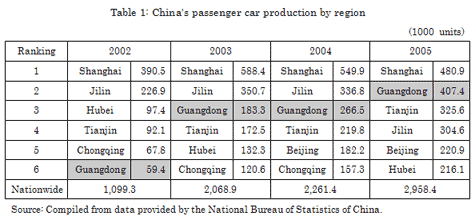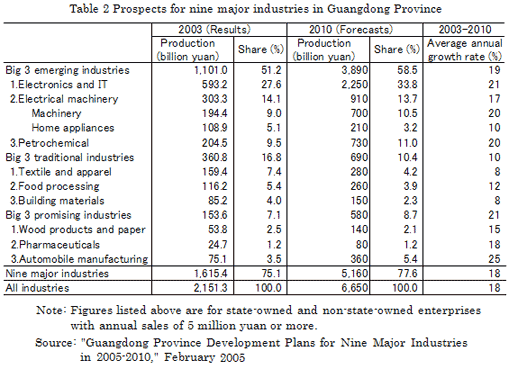In spring this year, I had an opportunity to meet with Guangzhou Mayor Zhang Guangning while visiting the capital city of Guangdong Province on a think tank mission tour to the Hong Kong-Zhujiang (Pearl River) Delta region organized by the Hong Kong Trade Development Council. During the meeting, some members of the mission suggested the possibility of Guangzhou ultimately becoming the Detroit of China, citing the rapidly growing presence of the automotive industry in the city. The mayor objected. "Guangzhou will not become the Detroit of China," he said, noting that, unlike in Detroit where automobile manufacturing is essentially the only industry, Guangzhou aims to foster the development of other industries along with automotive.
Whether labeled the "Detroit of China" or not, Guangzhou has certainly witnessed remarkable development of the automotive industry in recent years. In 2005, the automotive industry (including motorcycles and auto parts) generated 84.9 billion yuan in production, or 14.1% of the city's gross industrial production (based on figures for companies above a given size). As such, the automotive industry is now counted among the city's Big Three industries along with the electronics/information technology and petrochemical industries. The increasing presence of Japanese automakers that have, one after another, launched local operations in the form of joint ventures with major Chinese automakers has propelled the growth of the Guangzhou's automotive industry. Guangzhou Toyota Motor Co. began operations in May 2006, in the footsteps of Guangzhou Honda Automobile Co. and the Dongfeng-Nissan joint venture which launched local production in Guangdong in 1999 and 2003 respectively. Thus, Guangzhou is now emerging as a major automobile production base, with Honda in the east, Nissan in the north, and Toyota in the south; each surrounded by a cluster of associated parts and components manufacturers.
With Guangzhou as its nucleus, Guangdong Province vehicle production totaled 413,500 units in 2005. Of these, passenger cars reached 407,400 units, making Guangdong Province the second largest passenger car production base in China, second only to Shanghai at 480,900 units (table 1). Looking to the future, Toyota's production in Guangzhou is heading into full swing, while Hyundai Motor Co. of South Korea is set to launch local production in 2007 in a joint venture with Guangzhou Automobile Industry Group Co. with an aim of achieving annual production of 200,000 commercial vehicles in 2010. Given all these factors, Guangzhou will overtake Shanghai as China's largest automobile production base in the not-so-distant future.
The "Guangdong Province Development Plan for the Automotive Industry, 2005-2010" mapped out in 2004 estimates that the province's annual production capacity will reach 1.6 million vehicles in 2010, with much of that coming from Guangzhou. Of the total capacity figure, passenger cars will account for 1.4 million units (a 15% or greater share of the national passenger car market) while the proportion of vehicles for export in the total production will reach 10%. The plan also says that annual production capacity will further increase to 3 million vehicles (of which passenger cars make up 2.5 million units) in 2020. If realized, Guangzhou will become one of the world's leading automobile production bases, comparable to such cities as Detroit in the U.S. and Toyota in Japan.
Yet automobile manufacturing will not be the largest industry in Guangdong Province. In 2005, the provincial government announced the "Guangdong Province Development Plan for Nine Major Industries in 2005-2010" covering electronics and IT, electric machinery (machinery and home appliances), petrochemical, textile and apparel, food processing, building materials, wood products and paper, pharmaceuticals, and automobile manufacturing. According to the plan, automobile manufacturing is expected to post annual growth of 25%, the highest rate among the nine industries, but its share within overall industrial production will be only 5.4% in 2010, far below the levels of industries such as electronics and IT, electrical machinery, and petrochemical. The percentage will not exceed 10% even when the vehicle production volume is doubled by 2020.
Guangzhou has been developing by taking advantage of the high growth of the Chinese economy, the geographical location of Guangzhou as the hub of the South China economic zone which constitutes a part of "the world's factory," and the introduction of foreign capital. In addition to these factors, a virtuous cycle of production increase and income improvement has now emerged as another positive condition. Just as expected by Mayor Zhang, Guangzhou will likely further upgrade its overall industrial structure while maintaining a good balance between automobile manufacturing and other industries (table 2).




